Isaac Semenovich Brooke - a tireless creator, original designer, uncompromising leader

The universe is infinite, so immense that any point can be considered its center
Turning over the pages of the history of the development of domestic computing technology, it is impossible not to recall the outstanding inventor and experimenter Isaak Semenovich Brook. More than 100 scientific papers, 50 inventions, he made a significant contribution to the creation of small and control machines. A remarkable scientist, a corresponding member of the Academy of Sciences of the USSR and just an interesting person, it combined an irrepressible desire for new knowledge and fearlessness in translating ideas into reality. I.S. Brooke became the first director of the Institute of Electronic Control Machines (INEUM) of the USSR Academy of Sciences, where under his leadership small digital computers M-1, M-2, M-3, M-4, M-5, M-7-200 and M-7-800.

In the city of Minsk, on November 8, 1902, Isaac Semenovich Bruk was born in a Jewish family. The father was a simple employee in the tobacco factory, although the family was not rich, but the parents did everything possible so that their children received a good education and upbringing. In 1920, Isaac graduated from a real school, and his two sisters, Masha and Mirra, studied in a gymnasium and music school. Ever since his early youth, Isaac had shown considerable interest in technology, machinery, and various mechanisms. He was a frequent guest at the electromechanical plant "Energia", where he came in hoping to get unnecessary parts from the masters, glands. He brought them home, turning his room into a real workshop. As a sponge absorbed explanations about the principles of operation and device design machines. He was a very inquisitive boy, read a lot of J. Verne, J. London, drew, was fond of astronomy. While still studying at a real school, he was fascinated by the world of exact sciences.
')
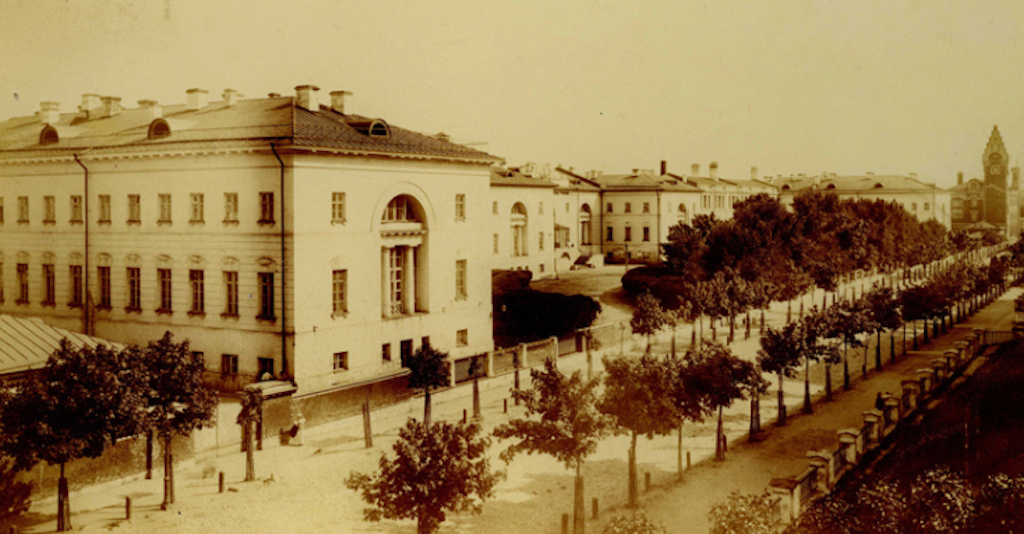
Electrotechnical Faculty of Moscow State Technical University N. E. Bauman
In 1920, Isaac entered the Faculty of Electrical Engineering, Moscow State Technical University. N. E. Bauman in Moscow. During his studies he was engaged in research, his thesis was about how to regulate asynchronous motors. Working in the All-Union Electrotechnical Institute. V. I. Lenin, took part in the creation of a new series of asynchronous motors and solving the problems of parallel operation of electric generators. Despite the fact that these were difficult post-war years, Brooke was happy doing his favorite thing.
Electrical Systems Laboratory
From 1930 to 1935, a young researcher worked at an electrical plant in Kharkov, where, under his watchful guidance, electric machines of the new design, explosion-proof asynchronous motors were created. Returning to Moscow, a talented young engineer was recommended by academician K. I. Schonfer to work at the Energy Institute of the USSR Academy of Sciences (ENIN). In the laboratory of electrical systems organized by Brooke, the regimes of powerful energy systems were calculated. The modeling of such systems required the creation of an alternating current settlement table, later called an analog computer. For that, in May 1936, Isaac Brooke was awarded the degree of Candidate of Technical Sciences. Thesis "Longitudinal compensation of power lines" he defended in October.
Research in the field of electric power required complex calculations, the scientist was well aware that moving forward without the help of computing tools is simply unrealistic. In 1939, under his leadership, a mechanical differential analyzer was created, which allowed solving systems of differential equations up to the sixth order. The dimensions of the device were impressive - the area occupied by them was 60 square meters. After the presentation of the integrator-analyzer at the Presidium of the Academy of Sciences, Brooke was elected a corresponding member of the Academy of Sciences of the USSR.
During the war, Brooke was engaged in research in the field of energy, research on the static stability of power systems. Under his leadership, work was carried out on the development of frequency control equipment and active power for the largest power plants of the USSR.
The scientist did not stop working on analog computers. Isaak Semenovich studied foreign publications about digital computers, was an ardent participant in a scientific seminar at the Presidium of the USSR Academy of Sciences, which raised questions about the need to automate calculations. As a result, in the summer of 1948, the Institute of Precise Mechanics and Computing began its existence. But, alas, Brooke and his laboratory were not part of the established institute. This is why this happened ...

B.I. Rameev
In 1948, I. S. Bruk, together with the young designer B. I. Rameyev, who was delirious with the idea of creating something like the first American Eniak computer, jointly developed a project of a digital computer with strict program control. In December 1948, they managed to obtain an author's certificate for the invention of the “Automatic Digital Machine”. The first copyright certificate for an invention in the field of digital electronic computing technology in the USSR. Isaac was a born creator of machines, but not the chief designer, and therefore, when in 1949 Rameyev was drafted into the army, the scientist lost his only performer. The loud project remained just on paper, unrealized.
Creation of M-1 - the first small digital computer or a bet on youth
Isaac Semenovich understood that now, more than ever, he needed helpers, because in 1950 he made a request to the personnel department of the Moscow Power Engineering Institute. In the laboratory of electrical systems, headed by Brook, began to gather young, full of enthusiasm people. According to the memoirs of M. A. Kartsev - at the beginning of the 50s he was the leading developer of computers in the laboratory - none of those who came to pick up the Soviet computer technology was an expert in this field, and in principle it was not known whether an electronic computer could exist. 10 people, among whom was a graduate of MEI N. Matyukhin, graduate students T. Alexandridi, M. Kartsev, who graduated from the technical school R. Shidlovsky,
started working on the development and creation of a small digital computer M-1.
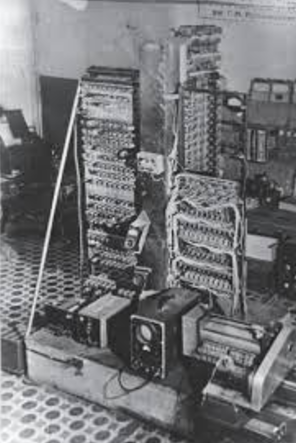
ATSVM M-1. View from the side of the magnetic drum
From the memoirs of Nikolai Yakovlevich Matyukhin:
Our group was small, and, probably, this was one of the main factors that forced I. S. Bruk to direct our efforts towards the creation of small (for those times) computers. Naturally, none of the recruits could imagine the whole complexity of the work ... Probably, that’s why we didn’t doubt that we would make the car, although the level of radio-electronic equipment of those years could be seriously worried by experienced specialists in the reality of this undertaking. Fortunately, we had no idea that the lamps and radio components tend to refuse quite often, and without any hesitation they set to work ...
The work was in full swing, after just two months in April 1950, I. S. Brook issued a decree of the Presidium of the USSR Academy of Sciences on the creation of a digital computer. In one of his books B.N. Malinovsky writes that such decisive actions were caused by the arrival of N.Ya. Matyukhin, a young radio technician in Brooke’s laboratory. He was insanely talented, while still a student participated in scientific research. Brooke put before him the first task - to design an important node of the computer, a tubeless decoder. Initially, even having no idea what a computer is, Matyukhin actually became the chief designer of M-1.
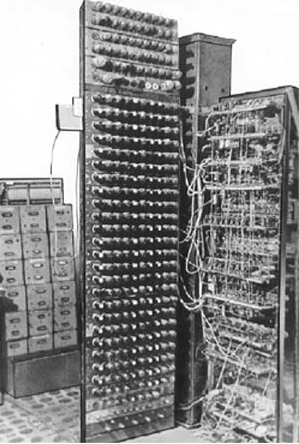
I. S. Bruk - the research manager of the development - provided the student with the necessary literature, repeatedly conducted conversations in which he dealt in detail with such issues as the principles of operation of a computer, the binary number system, and numerical calculation methods. His idea was to use German kuproksnye rectifiers instead of electronic tubes to build logical elements. M ‑ 1 implemented: a two-address system of commands, logical arithmetic and control logic of the machine were built on the basis of semiconductor diodes, cathode ray tubes from conventional oscilloscopes were used as memory elements, and an I / O device served as a teletype device.

young N. Ya. Matyukhin
In 1952, a machine built on the basis of an architecture with a stored program was put into operation. M-1 is the first computer in the world in which all logic circuits were made on semiconductors, performed 15-20 operations per second on 23-bit numbers and had a memory with a capacity of 256 words.

The program of the first problem solved on the M-1, 1951
It was an incredible breakthrough of a young gifted team - it took less than two years for M-1 to work. I would like to take into account the fact that all 9 employees, except Brooke, who were engaged in the creation of the device, did not even have academic degrees.
Creating a more advanced digital computer M-2

In the spring of 1952, I. S. Bruk singled out to MA Kartsev a group of 7 people for the development of a digital computer M-2. A group of graduates from the Moscow Power Engineering Institute, under the leadership of M. A. Kartsev, designed and built a more sophisticated computing machine, its performance was equal to the performance of the Strela computer and BESM — 2 thousand operations per second. Oscillographic CRTs were used as elements of the memory, and semiconductor diodes in logic circuits. Due to this, the M-2 had 4 times less electronic tubes, the electricity consumption decreased 7 times, to accommodate the device 22 square meters were required. meters. In January 1953, the M-2 was already working with a magnetic drum, and in the summer, with electronic memory.

In the next three years, Kartsev implemented the idea of shortened addresses in commands and shortened opcodes. In 1957, the M-2 was upgraded, the capacity of the OP was up to 4096 words. Calculations were carried out on a small computer for the Institute of Atomic Energy, the Institute of Theoretical and Experimental Physics of the Academy of Sciences of the USSR, the Design Bureau of Academician S. P. Korolev and many others. The M-2 machine was in a single copy and worked at the Energy Institute of the USSR Academy of Sciences for 15 years, it was rumored that they tried to create it in China.
Small computer M-3 for design and research institutions
In 1955 - 1956, Isaac Brooke formulated the concept of small computers and their differences from machines of maximum performance. The laboratory of control machines and systems of the Brook Academy of Sciences of the USSR and NIIEP began the development of a small computer M-3. The main ideas of the construction were proposed by Brooke, Matyukhin, Belynsky, Kagan, Dolkart.

Small computer M-3
The machine with a capacity of 30 operations per second operated with 30-bit binary numbers with a fixed point, had a two-address command format, a memory on a magnetic drum with a capacity of 2048 numbers, the performance increased when working with ferrite memory - 1.5 thousand operations per second. The occupied area of M-3 is 3 sq. M. meter, was produced commercially at the plant. S. Ordzhonikidze in Minsk. M-3 became the prototype for two industrial series of computers - "Minsk" and "Hrazdan". M-3 consisted of 3 cabinets:
- main cabinet with arithmetic unit, local and central control systems and machine control panel
- storage cabinet with magnetic drum, write and read amplifiers and number selection control device
- power cabinet
There was a table for the placement of telegraph equipment, which was used as a device for inputting information from punched tapes and for printing and punched tape.

Construction of the plant. S. Ordzhonikidze in Minsk
An interesting fact: the work on the creation of a computer M-3 was not originally included in the state plans, because the commission headed by Academician N. G. Bruevich did not want to take the car, two years passed before it was launched into mass production.
Creation of a control computer M4, M-5, M-7
The first domestic machine, built on the elemental base of the second generation, was developed in 1958–1964 to control the complex of radar stations in real time (the complex was part of an electronic system for monitoring artificial Earth satellites).
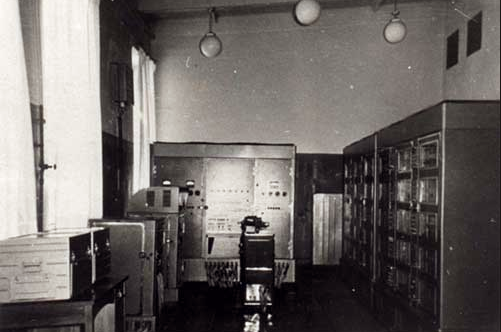
M-4
Initially, the M-4 with an OP with a capacity of 1024 24-bit numbers and constant program memory with a capacity of 1280 30-bit numbers worked with 23-bit numbers with a fixed point. The speed of M-4 - 30 thousand operations per second.
The upgraded M4-2M with a capacity of 220 thousand operations per second, with RAM up to 16 29-bit Kslov, since 1964, has been in serial production for 15 years. In 1968, peripheral machines M4-3M were created for it for input and primary data processing.
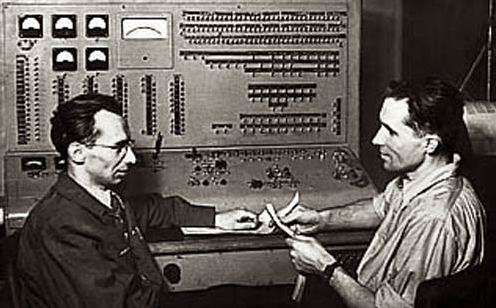
M-5
Under the leadership of I.S. In 1958-1961, Brooke created a universal computer M-5 on transistor elements and ferrite memory with multiprogramming mode of operation. It was developed for planning and economic calculations, it was built on the technical basis of the second generation, but in its architecture it was literally the predecessor of the computer of the third generation. The computer operated with 37-bit fixed and floating-point numbers, the 37-bit unicast instructions format contained the fields of address, keys, indices, and opcode.
M-5 never went into mass production, since the Minsk plant them. S. Ordzhonikidze, who was supposed to do this, at that time was launching the production of the Vesna computer.
In 1966-1969, I. S. Brook was the head of the development of the M-7 control machine. It was a digital sequential control machine with a memory on a magnetic drum and advanced communication devices with the object, operating with 12-bit numbers with a fixed point.

M-7 and its creators
Such a computer was created for control systems of powerful heat and power units of power plants, its functions were to support power unit operation modes, minimize fuel consumption, complex logic programs for starting and stopping a power unit, and analyzing combinations of power unit operation parameters.
Institute of Electronic Control Machines (INEUM) of the USSR Academy of Sciences
At the session of the USSR Academy of Sciences on automation in 1956, Isaak Semenovich made a report, which dealt with the main areas of industrial application of computing and control machines. The Institute of Electronic Control Machines of the Academy of Sciences of the USSR (INEUM) and many research institutes and design offices in the field of creating control machines and systems of the USSR were created to solve the scientific problem “Development of the theory, principles of construction and application of electronic control machines” set by Brooke in 1957 ". It was published by the Academy of Sciences of the USSR in 1958 in the series Questions of Soviet Science. The very concept of specialized control and computing machines was formulated here, their important role for the national economy was substantiated, the main directions of basic and applied research in the field of industrial automation and facility management with the help of specialized and control machines were highlighted, the ways of using machines in power engineering and mechanical engineering were outlined metallurgy, chemical production, in the planning and statistics of the national economy.
The control computers differed from the universal computers not only in the nature of their connection with the control object, but also in their high reliability, real-time operation, and the ability to use the environment in extreme industrial conditions.
The first director of INEUM was I. Bruk. In 1958 he was approved by the Presidium of the Academy of Sciences of the USSR on the problem “Development of the theory, principles of construction and application of control machines”.
From 1957 to 1969, M-4, M-5, M-7-200 and M-7-800 control machines were created within the walls of the INEUM.
I. S. Bruk understood that in addition to the use of computers for scientific calculations and object management, they can serve to process economic information and solve problems directly related to the modeling of the economy.

M-7-800
At INEUM, Isaac carried out work on the application of mathematical methods and computer technology to solve economic problems at the state level. Experts from the field of economics were involved, but his actions caused a storm of indignation from the leadership of the USSR State Planning Committee. Due to contradictions in 1964, Brooke resigned as director of the Institute of Electronic Control Machines.
Having retired, I.S. Brooke continued to work at INEUM as a scientific consultant and head of the INEUM Scientific and Technical Council. He took part in discussions and selection of architectural, circuit design and design solutions for ASVT-M models. In the future, his recommendations were used in the development of computers M-4000 / M-4030, M-400, CM 3 / CM 4.

COMPUTER M-4000
Brooke is a great teacher and mentor
Isaac Semenovich could not bear any difficulties, incomprehensibility. Simplicity, reliability and durability, this is what guided the talented scientist. These concepts fully characterize his style of work with students and machines. After many years, students warmly recalled the great mentor. Incredibly talented, optimistic about the result - Teacher with a capital letter. Respect, support, and no sign of failure reigned in his school. Brooke found an approach to everyone, lit a flame and zeal for creating something new.
L. S. Legizo: “He knew how to approach everyone, and knew how to create around him a certain creative atmosphere. As a result, he created such a team around himself, which gave powerful sprouts in our entire industry ... I would say that Brooke was like the core of a galaxy, generating some mental matter ... We learned specific technical solutions from him, got a lot of experience in thematic work, learned system approach to future developments ".
Isaac Semenovich Brook lived in the laboratory, constantly knocking out the equipment for the laboratory, money, bonuses to employees.
The scientist did not tolerate deception, hypocrisy, being a man of his word, did not forgive the failure to fulfill promises and neglect of work. He was not afraid to criticize and express his disagreement with issues concerning not only computers, but also government.
JS Bruk, as a teacher, played a significant role in the formation and development of domestic computing technology. His students, B. I. Rameyev, N. Ya. Matyukhin, M. A. Kartsev, G. P. Lopato, B. N. Naumov, subsequently created their own teams and schools in which they followed the principles of the engineering school of computer design and control. machines created by JS Bruk.
The basic principle formed by Brooke is a careful balance of performance characteristics, reliability and cost when developing small and middle class machines. He demanded a brilliant knowledge of the theoretical foundations of electrical engineering, pulsed technology, the ability to make bold technical solutions when conducting large-scale developments. He drew attention to the need for close cooperation between engineers and programmers during the development and creation of computers.
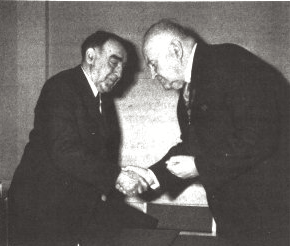
Isaak Semenovich Brooke on the left
Isaac Semenovich Brook was awarded four Orders of the Red Banner of Labor and USSR medals for achievements in the field of national science and technology. More than 100 scientific papers bear his name, he received more than 50 copyright certificates for inventions.
He died on October 6, 1974 and was buried in Moscow at Vvedensky cemetery.
I would like to finish the article with surprisingly simple and at the same time deep words of an outstanding inventor:
We must try to understand how things are arranged, what you are dealing with, how this could be done better, and not put up with the shortcomings noticed.
As advertising. Stock! Only now get up to 4 months of free use of VPS (KVM) with dedicated drives in the Netherlands and the USA (configurations from VPS (KVM) - E5-2650v4 (6 Cores) / 10GB DDR4 / 240GB SSD or 4TB HDD / 1Gbps 10TB - $ 29 / month and above, options with RAID1 and RAID10 are available) , a full-fledged analogue of dedicated servers, when ordering for a period of 1-12 months, the conditions of the promotion are here, existing subscribers can receive a 2-month bonus!
How to build the infrastructure of the building. class c using servers Dell R730xd E5-2650 v4 worth 9000 euros for a penny?
Source: https://habr.com/ru/post/370691/
All Articles